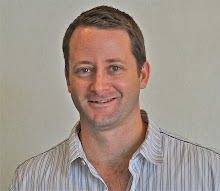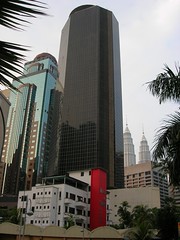Last day in Kuala Lumpur
Our last night in KL followed a round of Rusty Nails at the Marriott and began with a stroll through Chinatown, which, as best as I could tell, exists almost exclusively as a market for pirated goods. Although the satay and fruit stands and the non-existence of open container laws make this area a feast for the feast for the senses, provided one has a tolerance for intense open air hawking and haggling.
Earlier in the day, I went for a walkabout in KL's Golden Triangle with my new camera, in hopes of capturing interesting street scenes and to document architecture beyond than the two landmarks for which the city is justifiably famous, the Needle and the Petronas Towers.
KL is an exceedingly safe town, although the traffic that careens around the city's winding and perpetually merging streets, coupled with limited sidewalks, lend the city less to walking than do cities like Saigon, Rome or New York.
As a former photojournalist, I'm still quite conditioned to the notion that anything in open air is fair game for shooting, and, given this regionâs willingness to sacrifice privacy for security, I took to KLâs as though it were public gamelands. I still feel that way about the city, although an altercation with one man gave me cause to reconsider my position.
The owner of a parked motor scooter had about a dozen homeless cats dozing all over his bike, with a sign attached that solicited passers-by to provide homes for the felines. There were some really gorgeous Siamese among the cats and I stopped to snap a few shots, before politely nodding to the bike owner and walking off.
I have a really tortured appreciation for cats, in that I find them to be quite beautiful, affectionate and intelligent animals. But my allergies and my pit bull rule out any room in my life for these creatures.
Regardless, within less than a minute, another man nearby chased me down and demanded that I delete the photos.
Taking a page from Charlie's book, I feigned ignorance via an maddeningly halting Russian accent. One of the things I've learned traveling is that Americans unwittingly walk around with neon signs above their heads that exhort locals to take advantage of them and their gobs of cash. Given such realities, I find it is always best to pretend to be of some other nationality whose language I am confident no local would have bothered to learn. Sometimes itâs French, sometimes some Slavic-Russian combo, sometimes itâs my native Georgia Redneck.
This time, I sputtered Russian-sounding gibberish at my accoster and pretended not to know how to operate the camera (Agh ... ugh ... I heef buy theesz ... agh ... to-deee, yeesz?). Finally, the poor bastard realized that this was a competition to see who could waste the most of the otherâs time and that I was bound to win this war of attrition.
Notwithstanding that encounter, seeing the KL by foot affords an extraordinary glance at a city that is multicultural to a degree that renders such boasts by American metropoli laughable. Draped Muslim women stroll past an endless array of Chinese restaurants, while dark-skinned Indians and Pakistanis man the doors of gleaming new hotels. Elsewhere, Maylay, Japanese, Australians and countless other ethnic groups mill about the areaâs shopping districts.
Later that night, a cab driver who claimed to be of the same clan as the ousted Taliban of Afghanistan talked at length about the virtues of KL as a multicultural city. The notion that separation of church and state is anathema to any predominately Muslim society is exposed as a myth in Malaysia. The country government is a constitutional monarchy and the driver touted cultural mixing as a real point of pride here. He predicted that the prolific ethnic mixing would, in a generation, result in a unique, ethnically homogenous society that contained strains of every race in Asia and Australia.
Back in Chinatown, the air was perfumed with the carcinogenic delights of a hundred satay stands and the fruits of the land were represented abundantly at dozens of markets, but the primary commodities the packed district are pirated DVDs and CDs, imitation Rolex and Cartier watches and all manner of imitation brand name leather bags and apparel. It's a marvelous place to test one's bargaining abilities. I was initially pleased at having settled at $17 for a stainless steel Rolex Explorer II. Buyerâs remorse, valid or not, inevitably follows such transactions, but given the types of prices pitched to Americans, who are widely presumed to have vastly more money than street wisdom, I felt good about the deal. Fellow travelers experienced in such things agreed the watch was in relatively good shape for a fake and I took some strange comfort in seeing the salesmanâs prodigious array of tools next to his wares. Compared to the other hucksters in the market, my salesman was a veteran, blessed with a kind face, a rare patience with the process and a genuine sense of pride about the quality of his fakes.
Later we proceeded to Passage to India, one of the city's many delicious offerings of Indus fare, before heading to one of an inexplicably large number of Cuban-themed bars in this city. Almost as inexplicable is the absolute dearth of Meyers Rum in these places. Watching large quantities of East Asians salsa en masse to an all-Asian Latin group is truly one of those "Lost in Translation" moments where a relatively giant gringo like me struggles helplessly to make sense of a scene of mind-bending cultural absurdity.
The next day at 7 a.m. we had to depart the Ritz post-haste to take a bus ride to Penang. Estimations ranged from four to eight hours. Planned visits included a coffin manufacturing factory. More strangely, given our programâs proximity to Dellâs headquarters in suburban Austin (Round Rock), a visit to a Dell factory is also on tap. Now don't get me wrong: As a student of business, it's hard for me to regard Dell with anything less than admiration for the way its direct model practically rival Gutenberg's Bible and Henry Ford's first car factory for revolutionizing the relationships between operational efficiency and cash flow management. But it takes the average Texas MBA less than one semester before he's damn near intellectually constipated by Dell Holy Writ in the form of endless case studies on the company.
Labels: Personal









0 Comments:
Post a Comment
<< Home